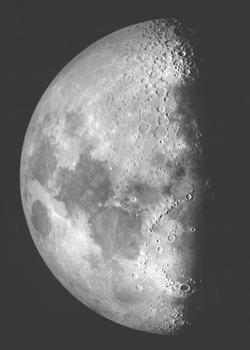NASA Research Team Reveals It Has An Earth-Like Core
 State-of-the-art seismological techniques applied to Apollo-era
data suggest our moon has a core similar to Earth's. Uncovering
details about the lunar core is critical for developing accurate
models of the moon's formation. The data sheds light on the
evolution of a lunar dynamo -- a natural process by which our moon
may have generated and maintained its own strong magnetic
field.
State-of-the-art seismological techniques applied to Apollo-era
data suggest our moon has a core similar to Earth's. Uncovering
details about the lunar core is critical for developing accurate
models of the moon's formation. The data sheds light on the
evolution of a lunar dynamo -- a natural process by which our moon
may have generated and maintained its own strong magnetic
field.
The team's findings suggest the moon possesses a solid,
iron-rich inner core with a radius of nearly 150 miles and a fluid,
primarily liquid-iron outer core with a radius of roughly 205
miles. Where it differs from Earth is a partially molten boundary
layer around the core estimated to have a radius of nearly 300
miles. The research indicates the core contains a small percentage
of light elements such as sulfur, echoing new seismology research
on Earth that suggests the presence of light elements -- such as
sulfur and oxygen -- in a layer around our own core.
The researchers used extensive data gathered during the
Apollo-era moon missions. The Apollo Passive Seismic Experiment
consisted of four seismometers deployed between 1969 and 1972,
which recorded continuous lunar seismic activity until late-1977.
"We applied tried and true methodologies from terrestrial
seismology to this legacy data set to present the first-ever direct
detection of the moon's core," said Renee Weber, lead researcher
and space scientist at NASA's Marshall Space Flight Center in
Huntsville, Ala.
In addition to Weber, the team consisted of scientists from
Marshall; Arizona State University; the University of California at
Santa Cruz; and the Institut de Physique du Globe de Paris in
France. Their findings are published in the online edition of the
journal Science. The team also analyzed Apollo lunar seismograms
using array processing, techniques that identify and distinguish
signal sources of moonquakes and other seismic activity. The
researchers identified how and where seismic waves passed through
or were reflected by elements of the moon's interior, signifying
the composition and state of layer interfaces at varying
depths.
Although sophisticated satellite imaging missions to the moon
made significant contributions to the study of its history and
topography, the deep interior of Earth's sole natural satellite
remained a subject of speculation and conjecture since the Apollo
era. Researchers previously had inferred the existence of a core,
based on indirect estimates of the moon's interior properties, but
many disagreed about its radius, state and composition.

A primary limitation to past lunar seismic studies was the wash
of "noise" caused by overlapping signals bouncing repeatedly off
structures in the moon's fractionated crust. To mitigate this
challenge, Weber and the team employed an approach called
seismogram stacking, or the digital partitioning of signals.
Stacking improved the signal-to-noise ratio and enabled the
researchers to more clearly track the path and behavior of each
unique signal as it passed through the lunar interior. "We hope to
continue working with the Apollo seismic data to further refine our
estimates of core properties and characterize lunar signals as
clearly as possible to aid in the interpretation of data returned
from future missions," Weber said.
Future NASA missions will help gather more detailed data. The
Gravity Recovery and Interior Laboratory, or GRAIL, is a NASA
Discovery-class mission set to launch this year. The mission
consists of twin spacecraft that will enter tandem orbits around
the moon for several months to measure the gravity field in
unprecedented detail. The mission also will answer longstanding
questions about Earth's moon and provide scientists a better
understanding of the satellite from crust to core, revealing
subsurface structures and, indirectly, its thermal history.
NASA and other space agencies have been studying concepts to
establish an International Lunar Network -- a robotic set of
geophysical monitoring stations on the moon -- as part of efforts
to coordinate international missions during the coming decade.
 ANN's Daily Aero-Linx (04.15.24)
ANN's Daily Aero-Linx (04.15.24) Classic Aero-TV: 'No Other Options' -- The Israeli Air Force's Danny Shapira
Classic Aero-TV: 'No Other Options' -- The Israeli Air Force's Danny Shapira Aero-News: Quote of the Day (04.15.24)
Aero-News: Quote of the Day (04.15.24) Airborne 04.16.24: RV Update, Affordable Flying Expo, Diamond Lil
Airborne 04.16.24: RV Update, Affordable Flying Expo, Diamond Lil ANN's Daily Aero-Term (04.16.24): Chart Supplement US
ANN's Daily Aero-Term (04.16.24): Chart Supplement US




